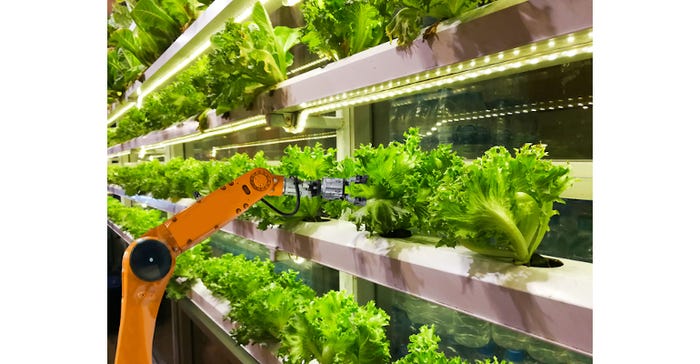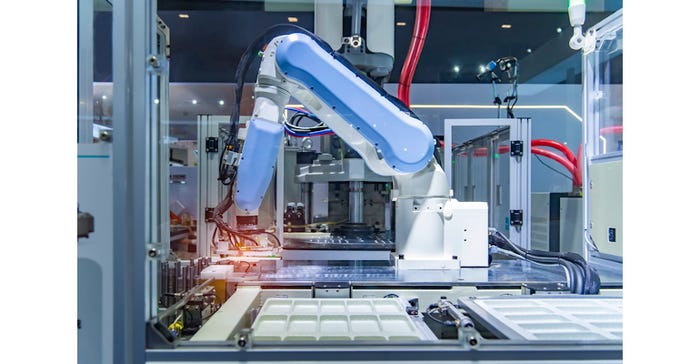Efficiency Tech: The New Driving Force in Sustainability Practices
Sensors and robotics can help manufacturers reduce resource and energy use and optimize operations, supporting a shift toward sustainable manufacturing.

Sustainability is top of mind at many organizations now, with 90% of executives saying it’s important for their companies. How effectively that awareness translates into impact depends on companies’ sustainability practices and the technology available to support them. Now, as the need and awareness grow more urgent to hit climate targets and adapt to global uncertainty, many organizations are exploring new ways to leverage technology for more sustainable practices.
At the same time that the energy crisis in Europe has been driving companies and consumers toward usage reductions and alternative energy sources, the global economic slowdown has been driving companies and consumers to reduce costs, which can often be achieved through optimization of resource use. Optimization is also a more impactful way for companies, governments, and the planet to reach net zero emissions goals compared to offsets. Fortunately for organizations that want to control costs and reduce their carbon footprint, we’re seeing a wave of exciting climate tech innovation that can optimize operations, reduce resource and energy use, enable circularity, and decrease emissions.
Technology for Resource and Energy Use Optimization
Sensors and Control Systems
Smart feedback loops and control systems enabled via remotely connected specialized sensors that gather and act on critical, real-time data can reduce resource use and minimize waste across industries. For example, in agriculture, sensors help optimize production with the lowest effective level of inputs like pesticides, fertilizers, and water and the least transportation time and cost to deliver them. “Smart building” technology is also already being used in some areas to detect the presence of people and adjust lights and HVAC systems accordingly. And, typically in industrial markets, predictive maintenance (PdM) enabled by sensors and data delivers services and repairs when needed to minimize scheduled maintenance costs and reduce unplanned downtime. PdM can also help commercial fleets, agricultural equipment, and food and pharmaceutical cold chains handle maintenance more efficiently and prevent disruptions. For example, one trash and recycling metering company is using smart cameras and AI to know when commercial bins are full to optimize pickup timing and routes for fuel conservation. Applying AI to collected data can also help make industrial processes themselves more efficient.
Robotics and Automation
Beyond sensors and optimizations based on data, organizations can also achieve better operational efficiency and enable circularity through innovative hardware applications to change the physical world itself. One robotics firm has developed a system that correctly identifies recyclables in waste streams with up to 99% accuracy and can sort up to 80 items per minute. Wide adoption of this kind of technology could help recover more of the $200 billion worth of recyclables that go to landfills each year. Indoor vertical farming of produce as well as aquaculture of seafood are additional examples where automated systems and robotics are enabling more efficient energy and resource use—both in food production as well as in the reduction of transportation costs and resource use to feed consumers.

Circularity and Combining Systems
In addition to sensors and automation, technologies are being combined in novel ways. For example, solar energy generated by panels in the day can be stored for use at night—and not just in ever-advancing batteries, but also with novel solutions like pumping water uphill during the day so it can be used to generate hydropower at night. Pairing these solutions with advances like fleet electrification by corporations, transit authorities, and government agencies is an example of how these solutions combine. Up to 15% of commercial and passenger fleet vehicles are expected to be electric by 2030. Another example is in finding new value from the byproducts of processes, such as using the sulfate generated from some mining applications to fuel new carbon dioxide removal process and generate useful new byproducts.
What’s Driving Sustainability Innovation Now
Engineers, designers, and sustainability managers have been working on improvements for a long time. Now, the cost of solar panels, EV batteries, and other energy-efficient hardware is trending down as demand rises and funding for sustainable technology increases. In addition to loans and grants in the Inflation Reduction Act of 2022, we’re also seeing more venture capital move into the climate technology space. Last year, more than 25% of all venture funding went into the climate tech space.
All these factors appear to be propelling climate tech toward a tipping point in terms of hardware innovation. Going forward, we expect progress in four main areas:
Sensor development and adoption. Sensors will continue to proliferate and capture new forms of valuable data, enabling more fine-grained predictive maintenance. Wider implementation of emissions sensors will create more-detailed accounting and feedback loops, raising awareness and making emissions reductions less reactive.
Better, easier to leverage AI. Advances in AI and its accessibility will make data-driven control systems to perform real-time optimizations and generate efficiency insights more ubiquitous—another way to create continuous and less-reactive sustainability practices.
More packaged sustainability hardware systems. Not every organization has the resources to build their own sensor and AI networks, and doing so wouldn’t be efficient for smaller-scale individual companies. We see a growing opportunity for platform creators, such as IoT systems that synthesize and generate insights from CO2 sensors, to serve companies in this category.
Increased focus on resource use circularity. Waste will be increasingly reduced as well as used in new ways. With the incentives and business models set up around carbon offsets, startups and existing businesses will see more benefit in addressing their waste. New product design will shift toward designing for longer useful life including repairability, which will put a renewed focus on future-proofing and making hardware extensible to get the most value out of it.

Pursuing New Solutions for Better Sustainability and Efficiency
Organizations that want to take advantage of new innovations in climate tech to improve their sustainability and reduce their expenses should start by identifying the “hot spots” where their investment can have the greatest impact, from raw material extraction to transformation, to use, to end of life. A lifecycle assessment (LCA) can help identify the organization’s current issues and their relative sizes. Pairing the hot spots identified in an LCA with analyses of operational costs and resource usage and then also assessing the feasibility and cost of solutions enables companies to quickly visualize what makes the most sense to pursue.
The goal of this approach is to identify the solutions that will deliver meaningful, long-term benefit, even if those solutions cost more up front or take longer to implement. For example, a consumer products manufacturer that makes resource-intensive products may get more value from adopting technology that reduces their resource consumption and increases their operational efficiency vs. prioritizing a smaller issue like making their packaging more sustainable. With a goal in mind, it’s time to decide whether to purchase a pre-built solution from a vendor, adapt existing technology to achieve the goal, or create something entirely new that’s not yet on the market. Here again, cost effectiveness, timeline, budget, long-term value, and competitive advantage should factor into the decision.
Defining sustainability improvement goals, selecting the right technology, and implementing it for maximum value are complex processes that may require working closely with internal teams, technology vendors, and hardware and sustainability experts to chart the optimal path. The potential benefits in terms of cost reduction, efficiency gains, emissions reduction, and ESG achievements make efficiency technology upgrades a sustainability strategy worth considering.
About the Author(s)
You May Also Like





